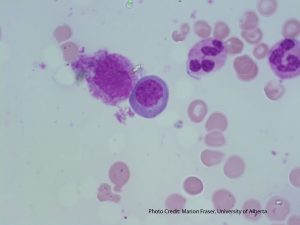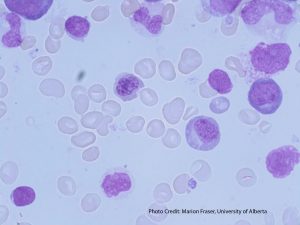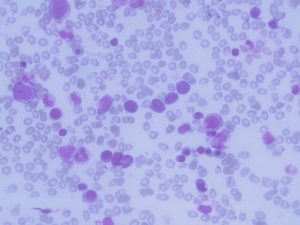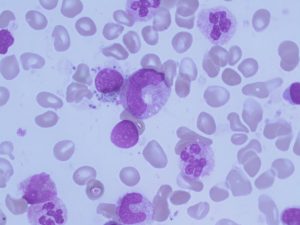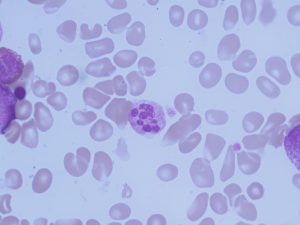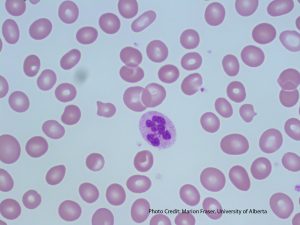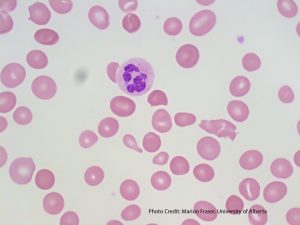35 Megaloblastic Anemia
Michelle To and Valentin Villatoro
- An image of a megaloblastic bone marrow showing nuclear-cytoplasmic asynchrony in a polychromatic normoblast. From MLS Collection, University of Alberta, https://doi.org/10.7939/R3Q81576M
- An image of a megaloblastic bone marrow showing nuclear-cytoplasmic asynchrony in erythroid precursors. From MLS Collection, University of Alberta, https://doi.org/10.7939/R3KK94T57
- An image of a megaloblastic bone marrow demonstrating erythroid hyperplasia and nuclear-cytoplasmic asynchrony. 40x magnification. From MLS Collection, University of Alberta, https://doi.org/10.7939/R3C24R36T
- An image of a megaloblastic bone marrow demonstrating a giant metamyelocyte. From MLS Collection, University of Alberta, https://doi.org/10.7939/R33J39G7T
- An image of a megaloblastic bone marrow showing a hypersegmented neutorphil and a giant band. From MLS Collection, University of Alberta, https://doi.org/10.7939/R3794191K
- An image of a megaloblastic bone marrow demonstrating a hypersegmented neutrophil. From MLS Collection, University of Alberta, https://doi.org/10.7939/R3V11W200
- An image of a megaloblastic peripheral blood smear showing a hypersegmented neutrophil and oval macrocytes. From MLS Collection, University of Alberta, https://doi.org/10.7939/R36970D1B
- An image of a megaloblastic peripheral blood smear showing a hypersegmented neutrophil and oval macrocytes. From MLS Collection, University of Alberta, https://doi.org/10.7939/R3B27Q653
- A megaloblastic peripheral blood smear demonstrating oval macrocytes. Small lymphocytes are present for size comparison. From MLS Collection, University of Alberta, https://doi.org/10.7939/R3XS5JZ3P
Cause(s):
Megaloblastic anemia occurs when there are defects in DNA synthesis that cause problems with blood cell production and maturation (all cells are affected, not just red blood cells). Megaloblastic anemia is most commonly caused by deficiencies in Vitamin B12 (cobalamin) and folate (folic acid). Both Vitamin B12 and folate are important factors used in the process of DNA synthesis.1
Cellular characteristics of Megaloblastic Anemia:
1. A characteristic finding in bone marrow smears for megaloblastic anemia would the appearance of nuclear-cytoplasmic (N:C) asynchrony in all cell lines.1 N:C asynchrony describes the inability of the cell’s chromatin to mature normally giving the nucleus a more immature, more fine, looser, and larger appearance than expected compared to that of the cytoplasm. Cytoplasm maturation is not affected and matures normally. Due to these characteristics, the cells are described as megaloblastic.1,2
2. Another characteristic finding on the peripheral blood smear would be the appearance of hypersegmented neutrophils. Hypersegmentation is described when either observation is present:1,2
-
5% or more neutrophils have 5 lobes
-
One neutrophil with ≥ 6 lobes
3. Oval macrocytes are also indicative of megaloblastic anemia.2
Function of Folate and Vitamin B12 in DNA synthesis:
Folate is ingested as folic acid which is inactive. The process of converting folic acid to its active form (Tetrahydrofolate, THF) requires the help of Vitamin B12.1 Vitamin B12 is used as a cofactor in a reaction that converts inactive folate (N5-methylTHF) into the active Tetrahydrofolate (THF) form which is then used to continue DNA synthesis.1,3 Without Vitamin B12 or folate, the nucleotide thymidine cannot be produced and DNA synthesis is impaired.2
Vitamin B12 (Cobalamin)
Absorption:
Available in eggs, milk, and meat. The low pH in the stomach causes Vitamin B12 to be released from ingested proteins. Vitamin B12 then binds to haptocorrin to be transported into the duodenum. In the duodenum, proteases release the Vitamin B12 and then it is picked up by intrinsic factor where it transports it to enterocytes of the ileum to be absorbed.1
Transport in circulation:
Once absorbed by the gastrointestinal tract, the transport protein called transcobalamin binds the Vitamin B12 to be transported to the rest of the body in circulation.1,2
Vitamin B12 deficiency:
Can occur to due to a variety of causes such as: malabsorption, bacterial and parasitic infection, inadequate intake in the diet, or impaired utilization by the body.1,2
Vitamin B12 deficiency can develop secondary to the absence of intrinsic factor (IF) which is used to help absorb Vitamin B12 into the body. IF deficiency can be caused by autoantibodies against IF and gastric cells resulting in a type of anemia called Pernicious anemia.1,3
Folate (Folic acid)
Absorption:
Folate can be found in yeast, milk, eggs, mushrooms, and leafy greens and is easily destroyed by heat. Folate is absorbed throughout the gastrointestinal tract as folic acid and converted into N5-methylTHF in the cells.1
Folate deficiency:
Causes of folate deficiency can be due to inadequate intake in the diet, malabsorption, drugs that interfere with use, and an increased need (such as during pregnancy or rapid growth).1,3
Laboratory Features of Megaloblastic Anemia:1,3
|
CBC: RBC, WBC, PLT, Hb, Hct: Decreased *MCV: Usually > 110 fL MCH: Increased MCHC: Normal RETIC: Normal to decreased |
PBS: *Ovalmacrocytes Howell-Jolly Bodies *Hypersegmented neutrophils Schistocytes Teardrop Cells |
BM: M:E Ratio: decreased (Ineffective erythropoiesis) Hypercellular *N:C asynchrony Enlarged precursors Giant metamyelocytes and bands |
|
Other Tests: Folate deficiency – Serum Folate: Decreased Vitamin B12deficiency – Serum Vitamin B12: Decreased – IF blocking antibodies – Antibody assays (Pernicious anemia) |
||
|
* Indicates the characteristic morphological findings in megaloblastic anemia blood smears |
||
References:
1. Hubbard J, Robinson S. Megaloblastic and nonmegaloblastic macrocytic anemias. In: Clinical laboratory hematology. 3rd ed. New Jersey: Pearson; 2015. p. 277-301.
2. Goossen LH. Anemias caused by defects of DNA metabolism. In: Rodak’s hematology clinical applications and principles. 5th ed. St. Louis, Missouri: Saunders; 2015. p. 314-30.
3. Nagao T, Hirokawa M. Diagnosis and treatment of macrocytic anemias in adults. J Gen Fam Med [Internet]. 2017 Oct 13 [cited 2018 Jun 25];18(5):200–4. Available from: http://doi.wiley.com/10.1002/jgf2.31

